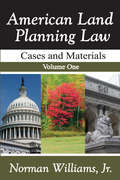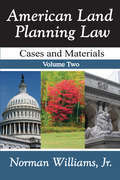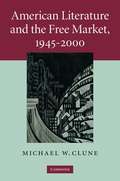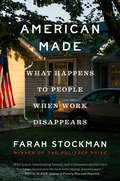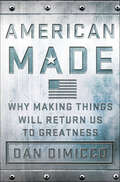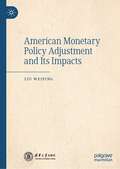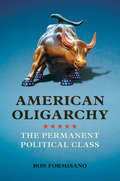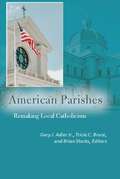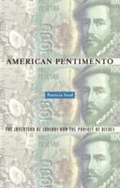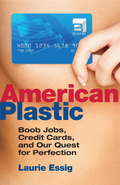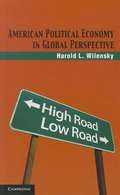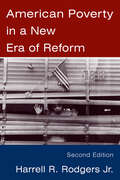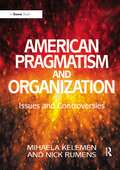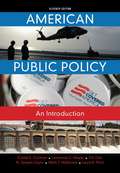- Table View
- List View
American Labour: The Story of the American Trade Union Movement (Routledge Revivals)
by Ernest DaviesFirst Published in 1943, American Labour presents a comprehensive story of the American trade union movement. The book discusses important themes like United States versus the workers; progress of unionization; labour and the new deal; industrial unions; behaviour of John L Lewis; labour and defence; the absence of a Labour Party in America and American labour after the war. With a preface from Harold J. Laski, this book is a must-read historical document for students of labour history, labour movement, and American history.
American Land Planning Law: Case and Materials, Volume 1
by Jr. WilliamsThe materials in American Land Planning Law are derived from decades of experience in teaching planning law at six planning schools and three law schools. Among the hypotheses included here, two are clearly vindicated in the reading. The first involves basic tenets in the approach referred to as "legal realism"—that courts play a major role in policy formation. A second hypothesis is implicit in the basic organizational principle of these materials, that planning problems arise from land use conflicts, and further, that courts have adopted distinctive policies on these conflicts.Norman Williams' organizational format is unique. The notes provided after each case have been omitted, due to a repetition that would result from what has already been said in the text. Instead, a list of questions is provided for the student to ponder, plus occasionally a necessary background, in order to focus attention on the essential turning point in each case. Williams also provides a complete list of cross-references to all standard treatises in the field, for those who wish to explore commentators' thoughts on the subject.The scope of these materials provides an exploration of the substantive problems involved in land use law, and the legal techniques which have been evolved to deal with them. The definition of this field of law as embodied in these materials focuses on urban and suburban planning problems. A quite artificial distinction between land use law and environmental law has been observed. This is an essential text containing important land use cases and should be read by all legal analysts, urban theorists and planners, and public policymakers.
American Land Planning Law: Case and Materials, Volume 2
by Jr. Norman WilliamsThe materials in American Land Planning Law are derived from decades of experience in teaching planning law at six planning schools and three law schools. Among the hypotheses included here, two are clearly vindicated in the reading. The first involves basic tenets in the approach referred to as ""legal realism"" - that courts play a major role in policy formation. A second hypothesis is implicit in the basic organizational principle of these materials, that planning problems arise from land use conflicts, and further, that courts have adopted distinctive policies on these conflicts.Norman Williams' organizational format is unique. The notes provided after each case have been omitted, due to a repetition that would result from what has already been said in the text. Instead, a list of questions is provided for the student to ponder, plus occasionally a necessary background, in order to focus attention on the essential turning point in each case. Williams also provides a complete list of cross-references to all standard treatises in the field, for those who wish to explore commentators' thoughts on the subject.The scope of these materials provides an exploration of the substantive problems involved in land use law, and the legal techniques which have been evolved to deal with them. The definition of this field of law as embodied in these materials focuses on urban and suburban planning problems. A quite artificial distinction between land use law and environmental law has been observed. This is an essential text containing important land use cases and should be read by all legal analysts, urban theorists and planners, and public policymakers.
American Literature and the Free Market, 1945–2000
by Michael W. CluneThe years after World War Two have seen a widespread fascination with the free market. Michael W. Clune considers this fascination in postwar literature. In the fictional worlds created by works ranging from Frank O'Hara's poetry to nineties gangster rap, the market is transformed, offering an alternative form of life, distinct from both the social visions of the left and the individualist ethos of the right. These ideas also provide an unsettling example of how art takes on social power by offering an escape from society. American Literature and the Free Market presents a new perspective on a number of wide ranging works for readers of American post-war literature.
American Made: What Happens to People When Work Disappears
by Farah StockmanWhat happens when Americans lose their jobs? In this illuminating story of ruin and reinvention, Pulitzer Prize-winning journalist Farah Stockman gives an up-close look at the profound role work plays in our sense of identity and belonging, as she follows three workers whose lives unravel when the factory they have dedicated so much to closes down. &“With humor, breathtaking honesty, and a historian&’s satellite view, Stockman illuminates the fault lines ripping America apart.&”—Beth Macy, author of Factory Man and DopesickShannon, Wally, and John built their lives around their place of work. Shannon, a white single mother, became the first woman to run the dangerous furnaces at the Rexnord manufacturing plant in Indianapolis, Indiana, and was proud of producing one of the world&’s top brands of steel bearings. Wally, a black man known for his initiative and kindness, was promoted to chairman of efficiency, one of the most coveted posts on the factory floor, and dreamed of starting his own barbecue business one day. John, a white machine operator, came from a multigenerational union family and clashed with a work environment that was increasingly hostile to organized labor.The Rexnord factory had served as one of the economic engines for the surrounding community. When it closed, hundreds of people lost their jobs. What had life been like for Shannon, Wally, and John, before the plant shut down? And what became of them after the jobs moved to Mexico and Texas? American Made is the story of a community struggling to reinvent itself. It is also a story about race, class, and American values, and how jobs serve as a bedrock of people&’s lives and drive powerful social justice movements. This revealing book shines a light on a crucial political moment, when joblessness and anxiety about the future of work have made themselves heard at a national level. Most of all, it is a story about people: who we consider to be one of us and how the dignity of work lies at the heart of who we are.
American Made: Why Making Things Will Return Us to Greatness
by Dan DiMiccoAmerican manufacturing is on life support—at least, that's what most people think. The exodus of jobs to China and other foreign markets is irreversible, and anything that is built here requires specialized skills the average worker couldn't hope to gain. Not so, says Dan DiMicco, chairman and former CEO of Nucor, America's largest steel company. He not only revived a major US manufacturing firm during a recession, but helped galvanize the flagging domestic steel industry when many of his competitors were in bankruptcy or headed overseas. In American Made, he takes to task the politicians, academics, and political pundits who, he contends, are exacerbating fears and avoiding simple solutions for the sake of nothing more than their own careers, and contrasts them with the postwar leaders who rebuilt Europe and Japan, put a man on the moon, and kept communism at bay. We need leaders of such resolve today, he argues, who can tackle a broken job-creation engine by restoring manufacturing to its central role in the U.S. economy—and cease creating fictitious "service businesses" where jobs evaporate after a year or two, as in a Ponzi scheme. With his trademark bluntness, DiMicco tackles the false promise of green jobs and the hidden costs of outsourcing. Along the way, he shares the lessons he's learned about good leadership, crisis management, and the true meaning of innovation, and maps the road back to robust economic growth, middle-class prosperity, and American competitiveness.
American Monetary Policy Adjustment and Its Impacts
by Liu WeipingThis book reviews the historical evolution of U.S. monetary policy, and then uses various methods such as mathematical models and econometric analysis to study the impact of U.S. monetary policy adjustments on the domestic economy and the spillover effects on the world economy. Finally, it summarizes the challenges faced by the Chinese economy in the post financial crisis era and proposes relevant countermeasures and suggestions for China to respond to U.S. monetary policy adjustments.
American Negro Slavery: A Survey of the Supply, Employment, and Control of Negro Labor as Determined by the Plantation Regime
by Ulrich Bonnell PhillipsOriginally published in 1918, Ulrich Bonnell Phillips?s American Negro Slavery was widely hailed upon publication as the most comprehensive and accurate examination of enslaved Africans in the South by an academic historian. In the 1950s, however, a new generation of historians?led by Kenneth Stamp?challenged many of Phillips?s inaccurate and racist views about slavery. While many historians today acknowledge that American Negro Slavery is a pioneering work, most agree that Phillips?s misunderstandings, misinterpretations, and overt racism profoundly diminish his conclusions. This 1966 edition includes a foreword by Eugene D. Genovese, author of numerous academic works on slavery, including the Bancroft Prize-winning Roll, Jordan, Roll: The World the Slaves Made (1974).
American Oligarchy: The Permanent Political Class
by Ron FormisanoA permanent political class has emerged on a scale unprecedented in our nation 's history. Its self-dealing, nepotism, and corruption contribute to rising inequality. Its reach extends from the governing elite throughout nongovernmental institutions. Aside from constituting an oligarchy of prestige and power, it enables the creation of an aristocracy of massive inherited wealth that is accumulating immense political power. In a muckraking tour de force reminiscent of Lincoln Steffens, Upton Sinclair, and C. Wright Mills, American Oligarchy demonstrates the way the corrupt culture of the permanent political class extends down to the state and local level. Ron Formisano breaks down the ways this class creates economic inequality and how its own endemic corruption infects our entire society. Formisano delves into the work of not just politicians but lobbyists, consultants, appointed bureaucrats, pollsters, celebrity journalists, behind-the-scenes billionaires, and others. Their shameless pursuit of wealth and self-aggrandizement, often at taxpayer expense, rewards channeling the flow of income and wealth to elites. That inequality in turn has choked off social mobility and made a joke of meritocracy. As Formisano shows, these forces respond to the oligarchy 's power and compete to bask in the presence of the .01 percent. They also exacerbate the dangerous instability of an American democracy divided between extreme wealth and extreme poverty.
American Outsourcing
by Richard H.K. Vietor Alexander VeytsmanCovers the phenomenon of outsourcing jobs from the United States. Reviews the evolution of Mexico's Maquiladoras, manufacturing special economic areas in China, and information technology and service-sourcing in India. Also reviews exports/imports, exchange rates, wages, and jobs. Considers major outsourcer General Electric's moves to these countries and its plans. Compares Mexico and China, and India and China, asking what the United States and GE should be doing.
American Parishes: Remaking Local Catholicism (Catholic Practice in North America)
by Gary J. Adler Jr., Tricia C. Bruce, and Brian StarksParishes are the missing middle in studies of American Catholicism. Between individual Catholics and a global institution, the thousands of local parishes are where Catholicism gets remade. American Parishes showcases what social forces shape parishes, what parishes do, how they do it, and what this says about the future of Catholicism in the United States. Expounding an embedded field approach, this book displays the numerous forces currently reshaping American parishes. It draws from sociology of religion, culture, organizations, and race to illuminate basic parish processes, like leadership and education, and ongoing parish struggles like conflict and multiculturalism. American Parishes brings together contemporary data, methods, and questions to establish a sociological re-engagement with Catholic parishes and a Catholic re-engagement with sociological analysis. Contributions by leading social scientists highlight how community, geography, and authority intersect within parishes. It illuminates and analyzes how growing racial diversity, an aging religious population, and neighborhood change affect the inner workings of parishes. Contributors: Gary J. Adler Jr., Nancy Ammerman, Mary Jo Bane, Tricia C. Bruce, John A. Coleman, S.J., Kathleen Garces-Foley, Mary Gray, Brett Hoover, Courtney Ann Irby, Tia Noelle Pratt, and Brian Starks
American Pentimento: The Invention of Indians and the Pursuit of Riches (Public Worlds #7)
by Patricia SeedThe modern regulations and pervading attitudes that control native rights in the Americas may appear unrelated to the European colonial rule, but traces of the colonizers' cultural, religious, and economic agendas remain. Patricia Seed likens this situation to a pentimento - a painting in which traces of older compositions become visible over time -and shows how the exploitation begun centuries ago continues today. Seed examines how the goals of European colonialist in the Americas. The English appropriated land, while the Spanish and Portuguese attempted to eliminate "barbarous" religious behavior and used indigenous labor to take mineral resources. Ultimately, each approach denied native people distinct aspects of their heritage. Seed argues that their differing effects persist, with natives in former English colonies fighting for land rights, while those in former Spanish and Portuguese colonies fight for human dignity.
American Philanthropy in Its Global Context: The History, Law, and Politics of Giving (Global Perspectives on Philanthropy and Public Good)
by Thomas AdamPhilanthropy has become a staple of American society and culture. Associations, endowments, foundations, and limited dividend companies have funded education, culture, healthcare, religion, and social welfare. Yet American philanthropy is not as exceptional as it appears to European observers. American philanthropy was built upon European and Mediterranean precedents and evolved through the constant influence of philanthropic practices in other parts of the world. This book explores how philanthropic practices and institutions were introduced into American society and how they were Americanised during the 19th century. It provides a comprehensive history of American philanthropy and positions it within its wider global context.
American Plastic
by Laurie EssigThe riveting story of how cosmetic surgery and plastic money melted together to create a subprime mortgage crisis of the body Plastic surgery has become "the answer" for many Americans, and in American Plastic sociologist Laurie Essig explores how we arrived at this particular solution. Over the last decade there has been a 465 percent increase in cosmetic work, and we now spend over $12 billion annually on procedures like liposuction, face-lifts, tummy tucks, and boob jobs. In this fascinating book, Essig argues that this transformation is the result of massive shifts in both our culture and our economy--a perfect storm of greed, desire, and technology. Plastic is crucial to who we are as Americans, Essig observes. We not only pioneered plastic money but lead the world in our willingness to use it. It's estimated that 30 percent of plastic surgery patients earn less than $30,000 a year; another 41 percent earn less than $60,000. And since the average cost of cosmetic work is $8,000, a staggering 85 percent of patients assume debt to get work done. Using plastic surgery as a lens on better understanding our society, Essig shows how access to credit, medical advances, and the pressures from an image- and youth-obsessed culture have led to an unprecedented desire to "fix" ourselves.
American Plastic: Boob Jobs, Credit Cards, and Our Quest for Perfection
by Laurie EssigPlastic surgery has become "the answer" for many, and in American Plastic, sociologist Laurie Essig explores how we arrived at this particular solution. Over the last decade there has been a 465 percent increase in cosmetic work, and we now spend over $12 billion annually on procedures like liposuction, face-lifts, tummy tucks, and boob jobs. In this fascinating book, Essig argues that this transformation is the result of massive shifts in both our culture and our economy - a perfect storm of greed, desire, and technology. Using plastic surgery as a lens on better understanding our society, Essig shows how access to credit, medical advances, and the pressures from an image- and youth-obsessed culture have led to an unprecedented desire to "fix" ourselves.
American Police, A History: 1945-2012
by Thomas A. ReppettoPostwar America saw few changes to law enforcement in one hundred years. The little known San Francisco riot of August 1945 announced the violent events of the next half century. Most of the methods remained unchanged until the 1953 kidnapping of Bobby Greenlease in Kansas City, Missouri, that shook the country. The 1960s were dominated by civil rights struggles and major riots. Watts, Detroit, and Newark demonstrated how local police departments were unable to handle the disorders that engulfed those cities. The anti-war protest at the 1968 Chicago Democratic Convention is important to this narrative since the author was in charge of convention security. The police department was split on how to deal with the protestors: a major revelation of this book. The author also turned down an offer to become part of a unit later known as the "plumbers" made to him personally by Attorney General John Mitchell. The 1970s and '80s are the lowest points in modern American law enforcement until the emergence of "zero tolerance" by New York Commissioner William Bratton and Mayor Rudy Giuliani. 9/11 changes the landscape with the new focus on counter terror and new challenges to law enforcement. Thomas Reppetto began as a police officer, rising to Commander of Detectives in the Chicago Police Department. In 1970 he received a PhD in public administration from the Harvard School of Government. He taught at the John Jay College of the City University of New York and became dean of graduate studies, then vice president. He is retired and lives in the New York City area.
American Political Economy (2nd Edition)
by John T. MolloyWhy write a textbook called American Political Economy? What is American Political Economy, and how does it differ from American Government or Economics? These are logical questions which may come to mind as students begin their journey through these pages.
American Political Economy in Global Perspective
by Harold L. WilenskyThis book is a guide to claims about the proper role of government and markets in a global economy. Moving between systematic comparison of nineteen rich democracies and debate about what the United States can do to restore a more civilized, egalitarian and fair society, Harold L. Wilensky tells us how six of these countries got on a low road to economic progress and which components of their labor-crunch strategy are uniquely American. He provides an overview of the impact of major dimensions of globalization, only one of which - the interaction of the internationalization of finance and the rapid increase in the autonomy of central banks - undermines either national sovereignty or job security, labor standards, and the welfare state. Although Wilensky views American policy and politics through the lens of globalization, he concludes that the nation-state remains the center of personal identity, social solidarity and political action.
American Poverty in a New Era of Reform
by Harrell R. RodgersThis new edition of American Poverty in a New Era of Reform provides a comprehensive examination of the extent, causes, effects, and costs of American poverty nearly ten years after the passage of the Personal Responsibility and Work Opportunity Reconciliation Act (PRWORA) in 1996. The author includes the most current available demographic, budget, evaluation, and program data to evaluate the impact of this sweeping legislation on federal and state policies, as well as on poverty populations. This revised edition takes into account the economic slowdown that took place in 2001 through 2003. It examines the state decisions about how to implement PRWORA, and how changes have affected the poverty population and overall welfare system. The author identifies the positive implications of welfare reform along with problems that must be addressed. New features for this edition include an appendix of Internet sources a state-by-state tables of poverty rates.
American Power after the Financial Crisis
by Jonathan KirshnerThe global financial crisis of 2007–2008 was both an economic catastrophe and a watershed event in world politics. In American Power after the Financial Crisis, Jonathan Kirshner explains how the crisis altered the international balance of power, affecting the patterns and pulse of world politics. The crisis, Kirshner argues, brought about an end to what he identifies as the "second postwar American order" because it undermined the legitimacy of the economic ideas that underpinned that order—especially those that encouraged and even insisted upon uninhibited financial deregulation. The crisis also accelerated two existing trends: the relative erosion of the power and political influence of the United States and the increased political influence of other states, most notably, but not exclusively, China. Looking ahead, Kirshner anticipates a “New Heterogeneity” in thinking about how best to manage domestic and international money and finance. These divergences—such as varying assessments of and reactions to newly visible vulnerabilities in the American economy and changing attitudes about the long-term appeal of the dollar—will offer a bold challenge to the United States and its essentially unchanged disposition toward financial policy and regulation. This New Heterogeneity will contribute to greater discord among nations about how best to manage the global economy. A provocative look at how the 2007–2008 economic collapse diminished U.S. dominance in world politics, American Power after the Financial Crisis suggests that the most significant and lasting impact of the crisis and the Great Recession will be the inability of the United States to enforce its political and economic priorities on an increasingly recalcitrant world.
American Pragmatism and Organization: Issues and Controversies
by Nick RumensEmerging during the late nineteenth century in the diverse scholarship of US commentators such as Charles Sanders Peirce, William James and John Dewey, American pragmatism shaped many intellectual currents within a range of disciplines including politics, education, administrative science and religion. Despite attracting attention and interest due to its conceptualization of theory, in terms of its practical consequences for improving the human condition, American pragmatism struggled to maintain its influence and suffered a hiatus until it experienced a renaissance within scholarly circles during the 1970s. While renewed interest in American pragmatism continues to grow, with some scholars distinguishing between classical, neo and new forms of pragmatism, it is only relatively recently that organization studies scholars have drawn upon American pragmatist philosophies for shedding new light on aspects of contemporary organizational life. This edited collection builds on this emergent literature in an engaging and scholarly manner. American Pragmatism and Organization is a ground-breaking collection and distinctive in its book-length treatment of American pragmatism as a relevant resource for analysing organisations. It draws together an international body of research focused on the interconnections and interplay between American pragmatism and organizational phenomena, explores the theoretical possibilities afforded by pragmatist thinking for understanding organization, and illuminates the practical advantages of doing so.
American Prep: The Insider's Guide to U.S. Boarding Schools
by Ronald Mangravite#1 Best Seller in High School Test Preparation, SSAT & COOP - Comprehensive boarding school guideWhat is boarding school really like?What are my chances of getting into U.S. boarding schools?How do I evaluate private schools vs. public schools?What is boarding school really like? U.S. boarding schools offer a superb preparation for college bound students, but they are not for everyone. American Prep is the only comprehensive guide for parents and students interested in investigating, applying to, and succeeding at these great schools. Meticulously researched and thoughtfully written, American Prep is an essential guide through the world of U.S. boarding schools – their history and culture, their resources and support systems, their opportunities and challenges – and the only book that leads you through the entire prep school experience. You will learn about:Why boarding schools are increasingly valuable in the 21st centuryThe pros and cons of private school vs public schoolHow to select a school that is right for your student and your familyHow to navigate the admission process – detailed insider adviceThe emotional challenges of prep school for students and families – what to expect and whenHow to secure generous financial aid for prep schoolStudent success on campus – getting in is only the first stepAn insider's perspective on U.S. boarding schools: Award winning writer/critic Ronald Mangravite has multiple perspectives on the American prep school world. An alumnus of the Lawrenceville School, he is a current prep school parent, an alumni class officer, and an admissions volunteer. His extensive teaching experience includes universities and private schools, with service on admissions and curricula committees. He holds degrees from the University of California, Berkeley and UCLA.
American Prison: A Reporter's Undercover Journey into the Business of Punishment
by Shane BauerA ground-breaking and brave inside reckoning with the nexus of prison and profit in America: in one Louisiana prison and over the course of our country's history. <p><p> In 2014, Shane Bauer was hired for $9 an hour to work as an entry-level prison guard at a private prison in Winnfield, Louisiana. An award-winning investigative journalist, he used his real name; there was no meaningful background check. Four months later, his employment came to an abrupt end. But he had seen enough, and in short order he wrote an exposé about his experiences that won a National Magazine Award and became the most-read feature in the history of the magazine Mother Jones. Still, there was much more that he needed to say. <p> In American Prison, Bauer weaves a much deeper reckoning with his experiences together with a thoroughly researched history of for-profit prisons in America from their origins in the decades before the Civil War. For, as he soon realized, we can't understand the cruelty of our current system and its place in the larger story of mass incarceration without understanding where it came from. Private prisons became entrenched in the South as part of a systemic effort to keep the African-American labor force in place in the aftermath of slavery, and the echoes of these shameful origins are with us still. <p> The private prison system is deliberately unaccountable to public scrutiny. Private prisons are not incentivized to tend to the health of their inmates, or to feed them well, or to attract and retain a highly-trained prison staff. Though Bauer befriends some of his colleagues and sympathizes with their plight, the chronic dysfunction of their lives only adds to the prison's sense of chaos. To his horror, Bauer finds himself becoming crueler and more aggressive the longer he works in the prison, and he is far from alone. <p> A blistering indictment of the private prison system, and the powerful forces that drive it, American Prison is a necessary human document about the true face of justice in America.
American Promise: Equal Justice and Economic Opportunity
by Arthur I. BlausteinThis forcefully argued and carefully documented report by the National Advisory Council on Economic Opportunity criticizes the Reagan Economic Recovery Program on the basis that it separates economic theory from social policy, pursuing the former at the expense of the latter, which hurts the poor and could lead to social chaos. This controversial volume also argues that the current policy proposals for the 1980s ignore national standards of responsi-bility and accountability.The report focuses on five aspects of American social, economic, and po-litical life: unemployment and inflation; federal antipoverty programs and policies; the changing face of poverty and the myths that affect the poor; the role of voluntary associations and the shared moral values of our society; the particular problems of family, child care, and welfare for women in poverty.
American Public Policy: An Introduction (11th Edition)
by N. Joseph Cayer Lawrence C. Mayer Clarke E. Cochran T. R. Carr Mark McKenzieAMERICAN PUBLIC POLICY: AN INTRODUCTION engages students with a unique emphasis on specific, substantive issues of public policy. It also kindles discussion that helps make public policy personal as students apply their knowledge to real-life policies. The authors present policy material step-by-step-explaining each policy’s historical context, building a picture of the existing policy, and prompting students to evaluate and discuss possible alternatives. This new edition includes updated and expanded coverage on key policy issues, including immigration, unemployment insurance, gun control, and the Affordable Care Act.

